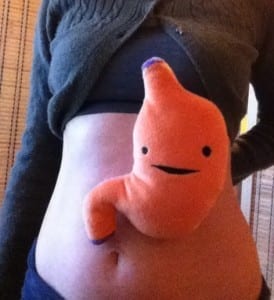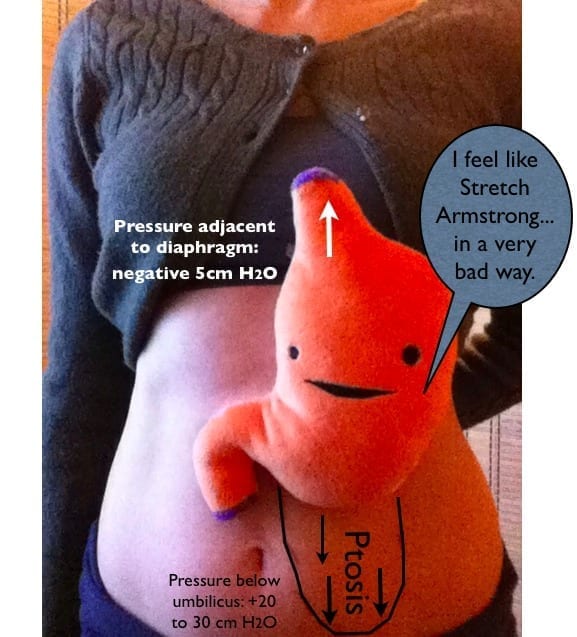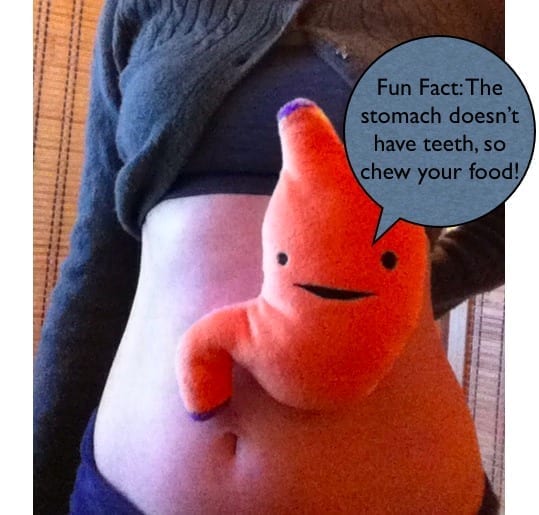Kyphosis is the natural curve of the thoracic spine. The abnormal excessive anterior curvature of the thoracic spine (think rounded upper back) is referred to hyperkyphosis, acquired or excessive kyphosis. Excessive kyphosis can lead to osteoporosis, headaches, shoulder impingement, neck pain, impaired breathing, impaired digestion, intrathoracic stomach and impaired heart and lung function. It can also lead to gastric ptosis (lengthening of the stomach). Contrary to popular belief the stomach is not the size of your fist, it’s much larger. The fundus (top) of the stomach starts between the fifth and sixth rib on the left side and the antrum (lower portion) is about level with midpoint between L2 and L3 (the second and third lumbar vertebra).

This is an X-ray of my stomach with contrast die to make the stomach stand out.
With Ptosis, the stomach can descend all the way into the pelvic cavity (see the black line on the photo below) and lose its tone and function. Ptosis is different than prolapse in that with ptosis the top of the stomach stays near the diaphragm, but the lower part of the stomach descends toward or into the pelvic area.

ptosis of the stomach
Radiography may reveal a very long stomach that extends all the way to the pubis! See an image of stomach ptosis (image a) on this page {click}. You can also see the small intestines (image b) and large (image c) intestines prolapsed into the pelvic area. Even though these images are from someone with Ehlers-danlos syndrome, a group of disorders that affect connective tissues, they demonstrate prolapses and ptosis very clearly.
How alignment affects the stomach:

Slouching sucks for your stomach!
“Acquired kyphosis (exaggeration of the normal curve of the thoracic spine) can also contribute to gastric ptosis, in a manner analogous to that of a tie which moves down as you lean forward,”- Jean-Pierre Barral D.O.
Another factor may be a retroverted uterus. (Side note: I’m starting to suspect that a posteriorly tilted pelvis is the number one contributor to retroversions.) With a retroverted uterus, the small intestines descend into the space where the uterus should be, pulling the stomach down with it. All of the organs are attached directly or indirectly to all the other organs and structures. The stomach is attached to the liver, spleen, duodenum, and diaphragm via ligaments, the diaphragm is attached to the rib cage, spine, and sternum. Alignment matters. For optimal function, internal organs need to be able to move with fluid and specific motions and slide and glide in relation to the surrounding tissue without restriction. They need mobility from external sources like from the motion the diaphragm creates with respiration, or from the motion of the beating heart. They also need fluid motility which is their unique intrinsic movement. The motility is an active movement the trained hand can actually feel. The motion traces the path the organ takes during embryological development and migration. Combining a posteriorly tilted pelvis with excessive kyphosis of the thoracic spine is not fun for the organs. Your structural alignment affects blood and lymph flow as well as the internal pressure system.
Some non-alignment causes of gastric ptosis: abdominal scarring from surgery or trauma, inflammation from infection and not chewing your food and eating too quickly. Not chewing your food, or eating too quickly a few times may not cause your stomach to lose tone, but if you eat like a petit cochon on a regular basis (petit cochon is a sweet French way of calling someone a little piggy), the stomach will lose its ability to bounce back. The stomach needs tone to mechanically churn during digestion. There’s also a chemical component to digestion that is affected by the stretch of the cholinergic fibers of the stomach.

Who Knew?
If you have gastric ptosis Visceral Manipulation™ may help. If you are in the Portland area you can make an appointment with me- click here. I combine Restorative Exercise™ with Visceral Manipulation™ to address the structural and visceral causes of your digestive complaints.
So what to do to correct or prevent excessive kyphosis? As always it’s best to take a whole body approach. No one area works in isolation. So, it’s best to work one-to-one with a Nutritious Movement™ certified Restorative Exercise Specialist to get a full body evaluation and individualized program. That said, I often recommend the following homework for clients I work with.
- Stop sitting like a vulture.
- Avoid spending the bulk of the day with internally rotated humeri.
- Mind your clavicles.
- See a Restorative Exercise Specialist™.
- Do your homework alignment snacks (click banner below): Can’t Get Enough of Shoulders, Everybody Needs a Little Shoulder Bolster, The Back Bones Are Connected to The Other Back Bones, Take a Load Off Your Chest… and Your Hips, Too, and Gotta Get Down to (Arm) Swingtown. Alignment Snacks are short recorded classes that you can download and watch anytime you wish. At $5 a class, they’re a bargain.
To make SKYPE appointment with me {click}.









Barbara,
Awesome info. I’m pretty sure between kyphosis, tucked pelvis, and three c sections I have an internal organ hell brewing. If you are working on alignment does it help your stomach go back up? Or does it just stay stretched? Forever? What possible effects would c sections have? Thanks for the info. I’m eating up any info on correcting kyphosis 😉 also can we do a Skype session where you tell me all your youth secrets? Lol, I look older than you and I’m 30 🙂
Hi Kathryn, You are funny. My youth secret might be all the preservatives in twinkles I ate when I was a kid. 😉
If the stomach has lost it’s tone, it may not rebound to it’s natural state, but alignment and visceral work can help it’s function. I have worked with gastric ptosis before that did improve greatly, but may have had to do with release from restriction. I suspect she had adhesions from her c section pulling the stomach down via the greater omentum. In fact, I felt a drag from the c section scar.
Loss of tone is different than organ position, so yes, alignment work will help organ position (think of the tie analogy) and help prevent loss of tone.
See that’s what I’m wondering after 3 c sections what is going on In there or what might be going on. I’m def. going to be working on alignment but I would like to look more into this massage thing. Or just request to have all that area checked out 🙂 and then find someone close to me that does what you do… 🙂
What city/state are you in? I can look for a VM practitioner in your area. The DR, won’t be able to tell if you have adhesions unless they do a laparoscopy, which unfortunately would cause more adhesions. If it were me I’d see a skilled Visceral Manipulation Therapist, or osteopathic physician trained in Visceral Manipulation. The Arvigo therapy or Chi Nei Tsang are also helpful for adhesions, but it really depends on what is going on specifically with you.
I live in federalsburg, md … Not a lot going on around here lol but I’m willing to drive, kind of lol, I’ve grown to hate driving since finding Katy 🙂 anyway… I would like to know what’s going on with me too.. Not that I have particular symptoms but I can feel adhesions or at least scar tissue right around the scar area not to mention the big flappy bulgy skin weird thingy lol right above the scar and also when I do the psoas release where bolster is under your hips.. I feel a big tug on the scar area, some days I’m numb all the way up to belly button other days I’m not… It’s so weird… None of my c sections went smoothly.. So I know there is some kind of weirdness going on in there…I kinda wanna know what’s going on inside my stomach after discovering the tucked pelvis/hyper kyphosis and how long it’s been going on ( 30 yrs, three kids later 😉 )
oh, And thank you 🙂
I couldn’t find a single Visceral Manipulation therapist or Craniosacral Therapist in all of your state! When I treat tight scar tissue that is tugging, I may use cupping over the scar tissue to break up adhesions and help with lymph drainage. Perhaps you can find a myofascial therapist experienced with abdominal work, or an acupuncturist who does cupping. Best of luck to you!
That’s what I figured … This state is behind the times 🙂 which is why I am excited to take the alignment course and start something here Lol anyway thank you for checking… 🙂 oh if we did Skype session can you show me some things I could do myself?
Wonderful, you are taking the alignment course! Yes, I could teach you some Chi Nei Tsang self-care belly massage and/or give you alignment feedback. Sometimes it’s helpful to have someone observe where you’re at in space. I looked for VM practitioners in Dover and Seaford and only found one in Dover, but they have only taken the VM1. I’d recommend seeing someone who has at least taken VM2 for what is going on with you. Here is a link to search VM practitioners in by zip code:http://www.iahp.com/pages/search/index.php And here is a link to find Arvigo therapists, it looks like there is one in Wilmington, DE https://arvigotherapy.com/practitioners?lname=&city=&state%5B%5D=DE&country%5B%5D=United+States There is one certified ATMAT practitioner in Upper Marlboro, MD
I desperately need your help. I have been having visceroptosis for half a year now. In the beginning it was only my stomach sagging down but now it’s all of my organs including the ones i pelvic area. It causes pain and discomfort and digestion issues. No one believes me because no doctors in my country have seen or heard of this problem before. What should I do? I feel so hopeless I can’t live a life like this. I’m so depressed 🙁 reading this made me happy because finally someone knows about it. Hoping to hear from you soon. thanks beforehand.
Hello I was told by my chiropractor that I have hyperkyphosis and she has been treating my back and ajusting it and the massage chair and electric something for pain she said I have it in my lower spine but didn’t explain much can you help